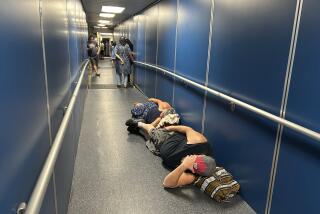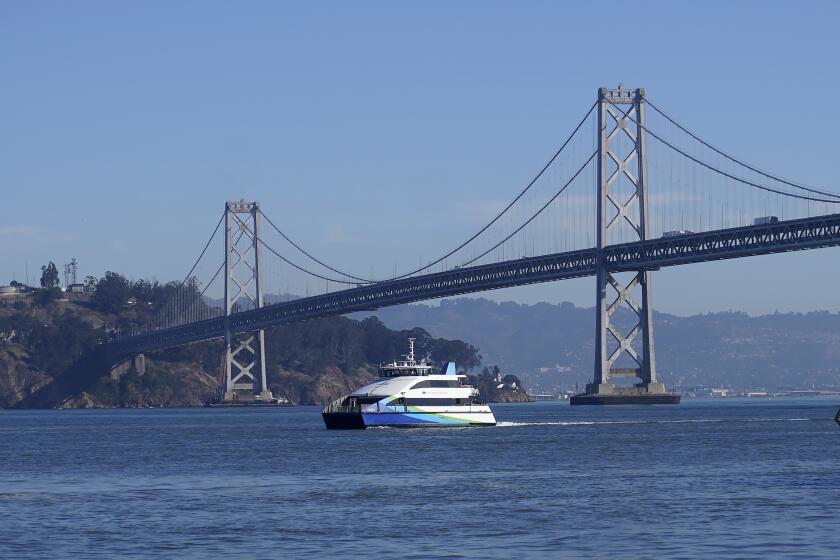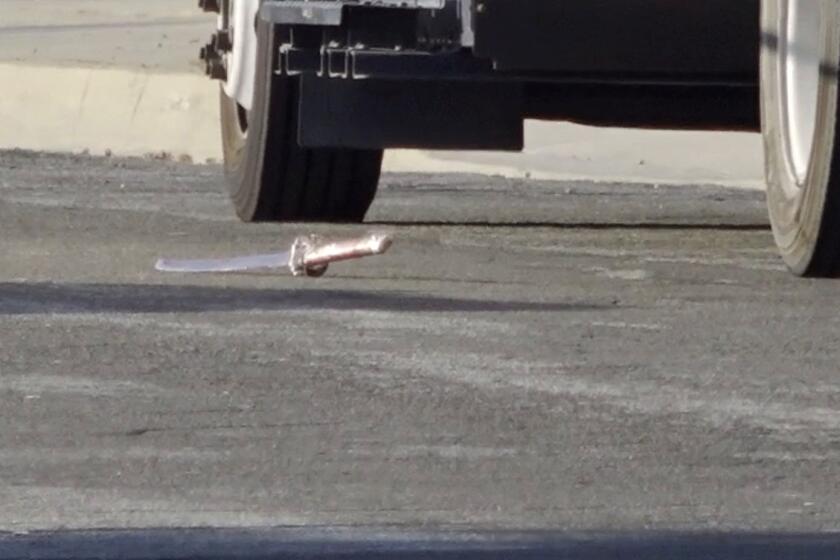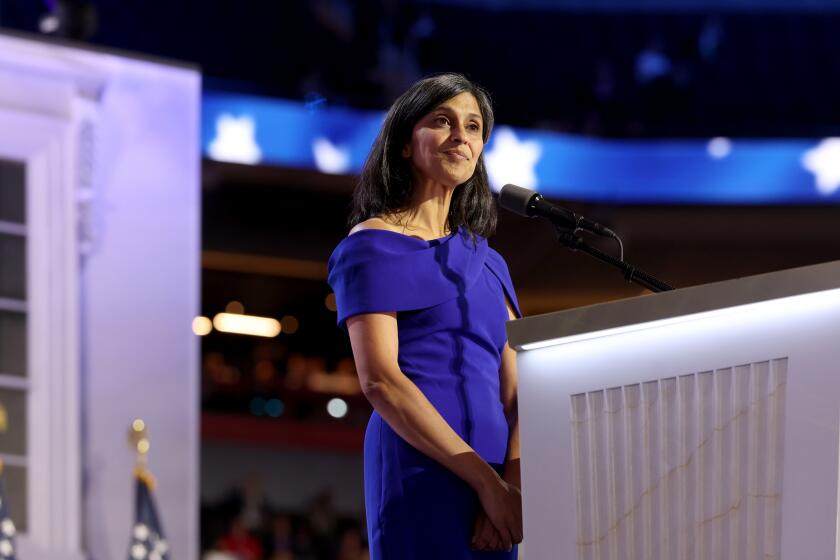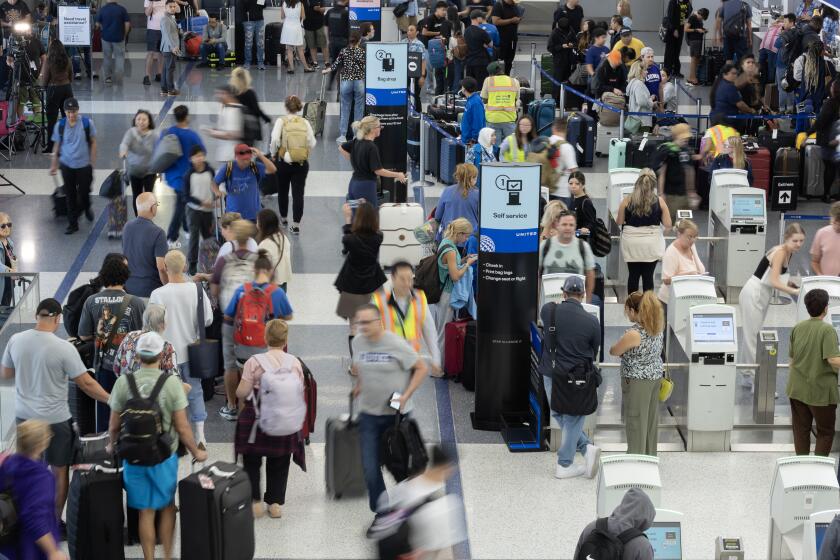L.A.’s Newest Place: Thai Town
Suspend disbelief for a moment and envision East Hollywood as Bangkok. Images of the Emerald Buddha festoon storefronts. Thai folk music accompanies classical dancers in gloriously colored gowns. Aromas of soothing mint and fiery chilies fill the nostrils.
It is the vision of a determined group of Thai immigrants, and it is slowly taking life in a worn patch of the East Hollywood flats. Today, Los Angeles city officials will officially designate the six blocks of Hollywood Boulevard between Normandie and Western as the nation’s first Thai Town.
For the record:
12:00 a.m. Feb. 3, 2000 For the Record
Los Angeles Times Thursday February 3, 2000 Home Edition Metro Part B Page 3 Metro Desk 1 inches; 32 words Type of Material: Correction
Thai Town--A story in Saturday’s editions of The Times on the newly designated Thai Town area of Los Angeles misspelled the name of the executive director of the Thai Community Development Center. She is Chanchanit Martorell.
Banners proclaiming Thai Town will be hung from lampposts; signposts on the Hollywood Freeway will mark Thai Town as a tourist destination. In coming months, statues of mythical figures carved in Thailand will be set at intersections on the boulevard and a Thai lotus garden will bloom near the Western Avenue Metro Rail station.
Today’s noontime ceremony, at Thailand Plaza, 5321 Hollywood Blvd., marks a triumph for an ethnic group that began immigrating in sizable numbers to the United States barely 30 years ago. East Hollywood has served as a point of entry for many of the approximately 80,000 Thais living in Southern California--reportedly the largest population outside Thailand.
Their progression follows a well-established pattern: Like the Cubans in Miami’s Little Havana and the Vietnamese in Orange County’s Little Saigon--Los Angeles’ Thai community is the latest group to employ a burgeoning population to advance its economic goals.
Like others, the Thais are trying to become more visible by emphasizing a unique cultural identity. They hope to attract such amenities as recreation centers, housing for seniors and perhaps funding for a museum.
But in working so closely with outsiders to shape their emerging community, Los Angeles’ Thai leaders are being praised by city officials for trailblazing a different way toward the quintessentially American goal of economic advancement. And they intend for their prosperity to boost the fortunes of their non-Thai neighbors.
“Thai Town will serve as an economic strategy for a part of town that has been neglected,” said Nancharit Martorell, executive director of the Thai Community Development Center, a nonprofit social service agency that has spearheaded efforts to create Thai Town. “There are such assets that could be tapped by everyone, be they Thai or Latino or whoever.”
Not a few Thais have noted that the idea of Los Angeles as Bangkok makes perfect sense. Bangkok’s Thai name means city of angels. Both cities are notorious for heat, pollution and traffic jams. Both exhibit exhilarating vibrancy.
A drive east on Hollywood Boulevard past Western Avenue is like a quick tour through the Americas and Eastern Europe. Guatemalan bodegas abut Mexican cantinas peopled with Russian diners. Armenian children walk to school accompanied by their grandmothers.
But on closer inspection, a theme begins to emerge in the form of elaborate Thai script. At the Bangkok Market, gourmands can stock up on bitter melon and round Thai eggplant. A Thai dessert shop offers preserved jackfruit, Pandan cookies and Kring Krang, crisply sweetened rice.
The large Silom supermarket occupies the middle of a block near Hobart Boulevard, its exterior the rose-hued color of dusk with ornate trimming and a spirit house, draped with colorful garlands and a stone-faced Buddha image, guarding the entrance from destructive forces.
This area has long been a magnet for immigrant groups, and it was the same for Thais who began coming in the 1960s, said Somchai Vongpiansuksa, who owns the popular Palms restaurant on Hollywood Boulevard.
Many Came First to Attend College
Many originally came to attend Southern California universities. There was a Thai market and bookstore on Melrose Avenue near Los Angeles City College, so people were familiar with the area. It was easy to find jobs in restaurants and shops, and real estate was cheap for new business owners.
Vongpiansuksa came over in 1982 and went to high school and college here. He worked as an electrician before inheriting restaurant duties from his wife’s aunt.
He is sitting in the restaurant’s sunny dining room, a little breathless after feeding a bus full of Indonesian tourists. Vongpiansuksa also gets plenty of locals, who dine on spicy hen soup in jungle curry, deer with green peppercorns and frog with crispy mint leaves.
He says Latinos love the spicy Thai food and make up a large part of his clientele, along with diners of nearly every other ethnicity.
Social scientists say it is not uncommon for a cuisine to form the core of a cultural identity in a foreign land.
Thai food “is a cuisine that has been able to [become] mainstream and maybe through it, other aspects of Thai culture and history will become better known to the people of Los Angeles,” said Don Nakanishi, a UCLA professor and director of the UCLA Asian American Studies Center.
Los Angeles’ Thai population boasts shops, banks, a chamber of commerce, a lively local press and a Thai Buddhist temple in North Hollywood that attracts thousands of worshipers. Yet, Nakanishi noted that many other groups have not been able to use such cultural signatures to create a beating heart.
“Ten to 15 years ago, there was an effort to develop a Manila Town centered downtown around the large Filipino population, but it never quite got off the ground,” Nakanishi said.
Nor has Los Angeles’ large Armenian population mustered anything like a Thai Town, despite heavy concentrations of Armenian immigrants in Hollywood and other areas.
Ara J. Najarian, a Glendale attorney who is prominent in the Armenian community, is a supporter of Thai Town, saying it “gives that community a sense of pride and I would hazard a guess that they’re going to work their hardest to make it a bright, shiny example of Thai culture.”
However, the concept of another ethnic enclave sliced out of the city strikes some as regrettable.
Los Angeles City Councilwoman Jackie Goldberg, who ushered Thai Town through city government, said, “One of the things you always worry about is if this will divide them off.”
But it was significant to Goldberg that the staff of the Thai Community Development Center includes other Asians, Latinos and whites, all intent on improving the East Hollywood business community in general.
“Their goal is to become much more involved in all aspects of community life in Los Angeles, bringing their own unique view of the world. From my point of view, that’s what America is all about,” Goldberg said.
Striking Move to Include Other Groups
That local Thai leaders would move so forcefully and reach out to include other groups has been viewed as striking because the community has never been as conspicuous as some Asian immigrant groups. Thais lack the longevity of Japanese and Chinese settlers. And unlike refugees from Vietnam or Cambodia, they share no binding trauma such as war.
In addition, the government in Thailand--a constitutional monarchy--is fairly stable. Los Angeles Thais can travel back and forth with ease. And yet, it is a sense of permanence in their new home that community leaders hope Thai Town will foster.
“They’re already calling Thai Town the 77th province,” said Thai Chamber of Commerce President Niphun Rojanasopondist, referring to the current 76 districts that make up Thailand.
But right now the 77th province needs sprucing up. Vacant lots dot the landscape, the streets are sometimes trashy, and crime is not uncommon, said Rojanasopondist, an exporter and shipper.
The goal is to make Thai Town a place where families can shop and find traditional cultural enrichments as well as unusual ones, such as Kavee Thongpricha, possibly the world’s only Thai Elvis impersonator.
The Thai Community Development Center won a $15,000 Department of Public Works matching grant for three beautification projects, which will not be completed in time for today’s ceremony. One is the gateway statues, which will be set at two Hollywood Boulevard intersections. The 6-foot-tall golden statues will be placed on 10-foot-tall pedestals and will depict the Kinaree, a mythical half-bird, half-human figure.
They are working with the Thai tourism board and Thai Airways International to make Thai Town a popular destination. Back home, Thai Town is big news. The ceremonies are being taped for broadcast in Thailand and the Los Angeles consul general will be at today’s ceremony.
“Once we have something like Thai town, it’s a unique place for Thai people when they visit Southern California,” said the Thai consul for information and economics, Surasak Suparat.
Rojanasopondist noted the long friendship between Thais and Americans--King Mongkut offered to send elephants to President Abraham Lincoln during the Civil War. Yet most Americans might only know of Thailand, then known by Westerners as Siam, and Mongkut from the musical “The King and I” or even confuse them with Taiwanese.
“We know a lot of history of the U.S.--about the Indians and Mexicans 200 years ago,” said Rojanasopondist. “Now it’s time for Americans to learn something about us.”
More to Read
Sign up for Essential California
The most important California stories and recommendations in your inbox every morning.
You may occasionally receive promotional content from the Los Angeles Times.
